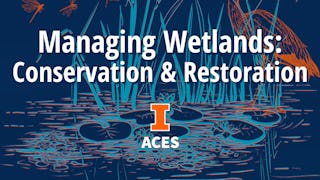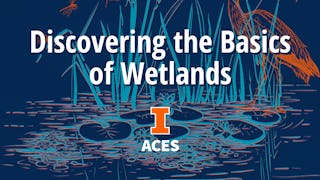In this course, you'll have the opportunity to explore some of the greatest classic golf architects who built courses from the 1880s through the 1920s and some contemporary golf course architects. You'll also learn about the methods of putting green construction and maintenance and examine bunker construction, maintenance, and expenses. Additionally, you'll explore routine cultural practices, such as thatch management, soil pH control, turf cultivation, rolling, topdressing, and localized dry spots, which are essential for proper golf course management. Lastly, you'll discover the strategies used to manage golf course diseases, which are crucial for ensuring a healthy and safe environment for golfers.

6 days left: Get a Black Friday boost with $160 off 10,000+ programs. Save now.


(14 reviews)
Skills you'll gain
Details to know

Add to your LinkedIn profile
6 assignments
See how employees at top companies are mastering in-demand skills

There are 5 modules in this course
Golf course architecture has a rich and fascinating history that spans centuries. From the earliest golf courses in Scotland to the modern-day masterpieces found worldwide, the design and construction of golf courses have evolved and adapted to golfers' changing needs and preferences. In this module, we will explore the history of golf course architecture, from the rudimentary courses of the past to today's innovative designs. We will examine the key figures and movements that have influenced the development of golf course architecture. We will also consider the various factors designers must consider when creating a world-class golf course.
What's included
4 videos3 readings1 assignment
Golf course construction is a complex process that involves careful planning, design, and execution. It requires a team of skilled professionals knowledgeable in various aspects of construction, including excavation, grading, landscaping, and irrigation. Every step is critical to ensuring the project's success, from selecting the right location to choosing the best materials and equipment. Whether building a new course or renovating an existing one, careful attention to detail is essential for creating a functional and aesthetically pleasing course that provides an enjoyable experience for golfers of all skill levels.
What's included
5 videos4 readings1 assignment
The condition of the turf on a golf course can significantly impact the game, making proper management essential. Factors such as mowing, humidity, irrigation, and fertility must all be considered when managing turfgrass on golf courses. This module will address key principles for implementing effective management strategies to ensure the turf remains healthy, green, and consistent for a superior golfing experience.
What's included
6 videos2 readings1 assignment
Effective soil management is at the heart of maintaining healthy and vibrant turf. By carefully monitoring and optimizing a soil's physical, chemical, and biological properties, you can promote strong roots, prevent erosion, and ensure that your greens, tees, and fairways remain healthy and resilient year-round. This module will cover the basics of soil management for golf courses, including soil testing, fertilization, and irrigation strategies to keep golf turf in top condition.
What's included
8 videos3 readings1 assignment
This module will discuss various diseases affecting golf courses and how to prevent and manage them. As a golf course manager or superintendent, it is essential to be aware of these diseases and take necessary measures to ensure the health and longevity of your course. Examine common turfgrass diseases, control strategies, and other issues. By the end of this module, you will better understand the common diseases that affect golf courses and the steps you can take to keep your golf course healthy and thriving.
What's included
4 videos1 reading2 assignments
Instructor

Offered by
Explore more from Environmental Science and Sustainability

University of Illinois Urbana-Champaign
 Status: Free Trial
Status: Free TrialUniversity of Illinois Urbana-Champaign
 Status: Free Trial
Status: Free TrialUniversity of Illinois Urbana-Champaign
 Status: Free Trial
Status: Free TrialUniversity of Illinois Urbana-Champaign
Why people choose Coursera for their career




Learner reviews
14 reviews
- 5 stars
92.85%
- 4 stars
7.14%
- 3 stars
0%
- 2 stars
0%
- 1 star
0%
Showing 3 of 14
Reviewed on Dec 15, 2024
Really helpful many explanations and full management
Reviewed on Jan 9, 2025
this course is vary good especially who want to do work in landscaping

Open new doors with Coursera Plus
Unlimited access to 10,000+ world-class courses, hands-on projects, and job-ready certificate programs - all included in your subscription
Advance your career with an online degree
Earn a degree from world-class universities - 100% online
Join over 3,400 global companies that choose Coursera for Business
Upskill your employees to excel in the digital economy
Frequently asked questions
To access the course materials, assignments and to earn a Certificate, you will need to purchase the Certificate experience when you enroll in a course. You can try a Free Trial instead, or apply for Financial Aid. The course may offer 'Full Course, No Certificate' instead. This option lets you see all course materials, submit required assessments, and get a final grade. This also means that you will not be able to purchase a Certificate experience.
When you enroll in the course, you get access to all of the courses in the Specialization, and you earn a certificate when you complete the work. Your electronic Certificate will be added to your Accomplishments page - from there, you can print your Certificate or add it to your LinkedIn profile.
Yes. In select learning programs, you can apply for financial aid or a scholarship if you can’t afford the enrollment fee. If fin aid or scholarship is available for your learning program selection, you’ll find a link to apply on the description page.
More questions
Financial aid available,

